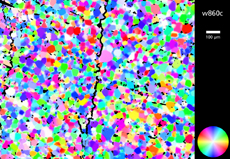4.4
ORIENTATION IMAGES OF EXPERIMENTALLY DEFORMED ROCKS
top / contents / section 4 / pages -- 4.1 -- 4.2 -- 4.3 -- 4.4 -- 4.5 -- 4.6 -- 4.7
Annealed microstructures of regime 1, 2 and 3 of dynamic recrystallization

Samples of Black Hills quartzite have been deformed in three regimes of dislocation creep (see 4.5 and 4.6), quenched, removed, carefully cut in half longitudinally, and a portion of the central section from one half was weld-sealed in Pt and annealed at the same P and T as the prior deformation, for about 5 days. These experiments allow us to correlate more exactly between the deformed material and the annealed equivalent.
Preliminary results:
Regime 1: Deformed original grains develop a broad maximum of c axes parallel to compression; annealing replaces the work-hardened original grains with polygonal strain-free grains with a weaker LPO.
Regime 2: Deformed original grains as well as new grains dynamically recrystallized by subgrain rotation develop a small circle girdle of c-axes about compression; annealing produces a change in the microstructure, to polygonal strain-free grains, but no change in the LPO.
Regime 3: Original grains are replaced by dynamically recrystallized grains after low strain, so their LPO depends on selective survival; dynamically recrystallized grains develop a weak small circle girdle of c-axes about compression. Annealing does not substantially change the microstructure or the LPO (Tullis & Heilbronner, 1999).
Left, from top to bottom:
- Annealed regime 1 (w875)
- Annealed regime 2 (w874)
- Annealed regime 3 (w860)

